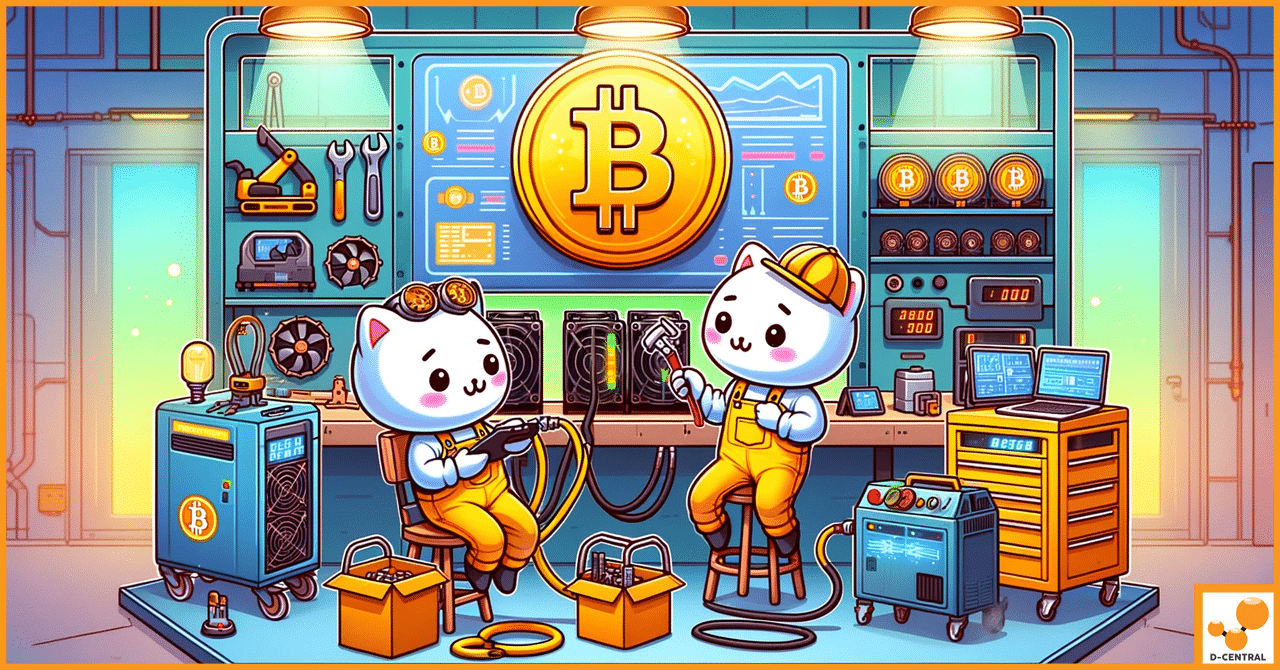
Here’s What to Look for in an ASIC Repair Service Provider
In the rapidly evolving world of cryptocurrency, ASIC (Application-Specific Integrated Circuit) mining has emerged as a cornerstone of the industry.
4479 Desserte Nord Autoroute 440, Laval, QC H7P 6E2
Curious about how to build ASIC miner? This guide provides clear, step-by-step instructions to help you assemble your own high-performance mining rig using essential components.
ASIC miners, or Application-Specific Integrated Circuit miners, are specialized devices designed exclusively for the purpose of cryptocurrency mining. Unlike general-purpose hardware such as CPUs and GPUs, ASIC miners are engineered to execute specific algorithms with remarkable efficiency and speed. This specialized hardware means they excel in mining particular cryptocurrencies, making them the go-to choice for serious miners who prioritize performance and energy efficiency. An asic mining rig can significantly enhance the mining process, especially in asic mining.
However, these powerful ASIC machines come with their limitations. While they are unrivaled in terms of speed and energy efficiency, ASIC miners are designed to mine only one type of cryptocurrency, which reduces their flexibility compared to versatile GPU mining. This specialization is a key aspect of crypto mining.
Despite this, the sheer computational power and energy savings they offer make them an indispensable tool for large-scale mining operations and enthusiasts alike.
Building a high-performance DIY ASIC miner requires a solid understanding and sourcing of key components to build asic miners:
Gathering components for Bitaxe and other open-source Bitcoin mining hardware like Nerdaxe and NerdQaxe requires patience and some electronics experience. These projects make the process accessible and enjoyable for hobbyists and decentralized purists.
At the heart of any ASIC miner are the ASIC chips, which perform the primary calculations necessary for mining specific cryptocurrencies. The architecture of these chips is meticulously designed to optimize for the target cryptocurrency’s hashing algorithm, making them incredibly efficient. This efficiency, coupled with reduced power consumption, is what sets ASIC chips apart from general-purpose hardware.
Sourcing ASIC chips can be a challenge due to supply bottlenecks and high initial investment costs. Builders need to ensure compatibility and quality when purchasing these chips, often from secondary markets or specialized suppliers like D-Central. For those involved in projects like Bitaxe, sourcing components can be done directly from D-Central or extracted from existing hashboards.
The Printed Circuit Board (PCB) serves as the backbone of your ASIC miner, distributing power and managing data processing among the various components, including the central processing unit. The control board in the design of a PCB involves careful consideration of layout, component placement, and thermal pathways to ensure efficient operation and heat dissipation.
Open-source projects like Bitaxe make the PCB completely transparent and modifiable, allowing builders to tailor the design to their specific needs or use it as-is. This flexibility is particularly beneficial for enthusiasts looking to experiment and optimize their mining rigs.
The Power Supply Unit (PSU) is a critical component that regulates power to all parts of the mining rig. Selecting the right PSU is essential to ensure that each component receives the correct power without the risk of overload. It’s important to consider the power consumption needs of your ASIC miner and avoid maxing out the PSU’s capacity. Additionally, understanding the role of power supplies can help in making informed decisions.
In building your ASIC miner, start by connecting the PSU to the PCB to ensure stable power distribution. D-Central offers a wide range of PSUs compatible with most home mining builds, ensuring reliable power for your rig.
Maintaining optimal heat transfer with effective cooling systems is crucial to prevent overheating. ASIC miners generate significant heat, and heat management is essential for sustained performance and extended equipment lifespan.
Cooling solutions can range from simple heatsinks and a cooling fan to more advanced setups like specialized shrouds and Cloudline fan systems for larger miners that blow cool air. Integrating these cooling systems is essential for maintaining the efficiency and profitability of your mining operations.
Building your own ASIC miner from scratch is a meticulous process that requires attention to detail and a solid understanding of the components involved. Before diving in, consider the technical expertise required and evaluate the overall complexity of the project. A systematic approach will help ensure you can build an asic miner successfully and minimize potential issues.
The basic steps involve:
Once these mining components are assembled, you can turn on the system and start mining all the components required of the mining process, including the final assembly.
A well-organized workspace is key to a successful ASIC miner build. A tidy, systematic setup reduces mistakes and enhances workflow. A dedicated computer can further improve efficiency. Online shops and specialized providers like D-Central offer essential tools and components.
Start by downloading design files and the Bill of Materials (BOM) to organize your build.
Mounting and soldering ASIC chips onto the PCB requires precision and care. The process involves:
Ensuring proper alignment and secure soldering is crucial for the ASIC chips to function correctly. Handle the chips with care, as excessive heat or pressure can cause damage.
Installing the PSU involves connecting it to the PCB to ensure stable power distribution. Selecting a PSU that meets the power consumption needs of your ASIC miner is crucial to avoid overloading and ensure reliable operation.
D-Central offers a range of PSUs suitable for various Bitcoin home mining builds.
Effective cooling systems are essential to manage the heat generated by ASIC miners. Heatsinks and cooling fans help dissipate heat and maintain optimal temperatures. Larger ASIC miners may benefit from specialized shrouds and Cloudline fan systems for more efficient cooling.
Integrating cooling systems is key to the longevity and profitability of your miner. D-Central offers various custom mods, mounts, and cooling accessories to enhance Bitaxe and other mining rigs’ performance.
Configuring your ASIC miner involves the following steps:
Ensure cooling fans and heatsinks are installed and connected to provide sufficient cooling during operation. Proper environmental conditions, such as temperature and humidity, are also vital for optimal functionality.
Installing firmware is a critical step in configuring your ASIC miner. Use a web-based ESP32 flashing tool to update the Bitaxe with the latest firmware, which manages ASIC chips, mining algorithms, and communication with the mining pool for optimized performance.
Optimizing and maintaining your ASIC miner is key to maximizing performance and profitability. Regular tasks include:
Proper setup and ongoing adjustments to settings like hash rate, power consumption, and cooling can significantly enhance your miner’s efficiency and lifespan. D-Central offers overclocking and efficient cooling accessories for micro-miners to aid these optimizations.
Routine maintenance is essential to keep your ASIC miner running efficiently and extend its lifespan. Tasks include cleaning dust, ensuring cooling systems function, and regularly updating firmware and software.
Ongoing performance checks and monitoring tools help prevent issues like overheating and maintain efficiency and profitability.
Performance optimization involves adjusting settings to maximize efficiency and profitability. Key factors include optimizing software settings, upgrading hardware, and managing power consumption. Proper processing power settings reduce heat generation, lower strain on components, and increase the miner’s lifespan.
Earnings from an ASIC miner depend on its efficiency, cryptocurrency price, and electricity costs, impacting overall mining profitability and mining difficulty. Regular adjustments may be necessary as mining conditions and cryptocurrency values change.
Cryptocurrency regulations vary by country, and it’s important to understand the specific guidelines regarding mining activities in your region. In most countries, building your own ASIC miner is legal, but power consumption may be subject to regulation in some areas, especially when it comes to mining bitcoin, mining cryptocurrencies, and mining cryptocurrency.
Staying informed about the regulatory landscape and adhering to ethical practices ensures responsible mined mining.
D-Central Technologies is the premier source for building a Bitaxe, offering full DIY kits and custom components. They provide extensive support and detailed guides for the assembly and configuration of Bitaxe miners, making the process accessible and enjoyable for hobbyists and decentralized purists.
The Bitaxe series consists of various models, each catering to different performance needs and budgets. From the beginner-friendly Bitaxe Max (100 Series) to the advanced Bitaxe Gamma (600 Series), D-Central offers a range of options to suit different preferences.
Accessories like custom stands, heatsinks, and fans further enhance the performance and efficiency of your mining rig.
Building your own ASIC miner is a rewarding project that combines technical skills with the excitement of cryptocurrency mining. From understanding the essential components to configuring and optimizing your rig, this guide has walked you through every step of the process. With the right tools, components, and support from D-Central Technologies, you’re well on your way to becoming a successful DIY miner. Start your journey today and experience the thrill of mining your own cryptocurrencies!
ASIC miners are specialized devices that excel in cryptocurrency mining due to their unmatched efficiency and speed. If you’re serious about maximizing your mining potential, using ASICs is the way to go!
To build an ASIC miner, you need ASIC chips, a printed circuit board (PCB), a power supply unit (PSU), and efficient cooling systems. With these essential components, you’ll be well on your way to mining success!
You can easily source components for building an ASIC miner through online shops, specialized providers, or secondary markets. Check out D-Central Technologies for full DIY kits and custom components to kickstart your project!
To successfully mount and solder ASIC chips onto the PCB, start by applying solder paste, then carefully place the chips, ensuring proper orientation. Finally, use a reflow oven or hot air tool to securely solder them, laying the foundation for your project’s success!
Regular maintenance is crucial for ASIC miners to prevent overheating and ensure they operate efficiently, extending their lifespan and maximizing your profitability. Stay proactive to keep your mining operation thriving!
DISCLAIMER: D-Central Technologies and its associated content, including this blog, do not serve as financial advisors or official investment advisors. The insights and opinions shared here or by any guests featured in our content are provided purely for informational and educational purposes. Such communications should not be interpreted as financial, investment, legal, tax, or any form of specific advice. We are committed to advancing the knowledge and understanding of Bitcoin and its potential impact on society. However, we urge our community to proceed with caution and informed judgment in all related endeavors.
Related Posts

In the rapidly evolving world of cryptocurrency, ASIC (Application-Specific Integrated Circuit) mining has emerged as a cornerstone of the industry.

In the rapidly evolving landscape of the Bitcoin mining industry, Application-Specific Integrated Circuits (ASICs) have emerged as the cornerstone of

In the digital age, where cryptocurrency mining has become a lucrative venture, the significance of network security cannot be overstated.